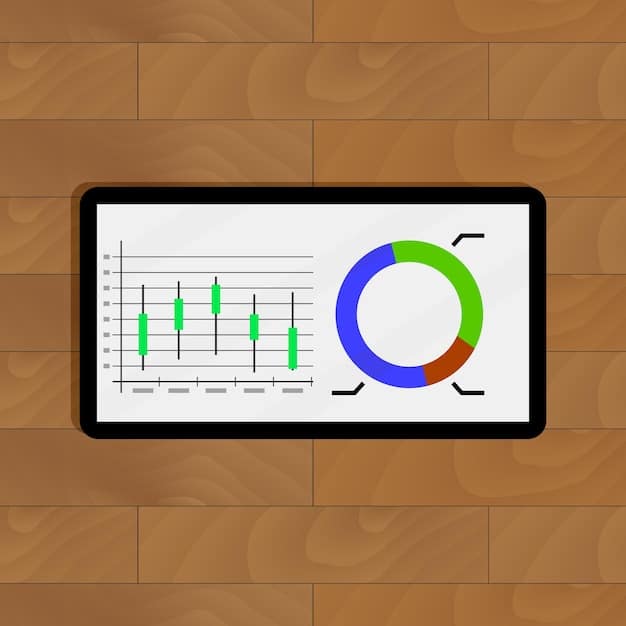How to Calculate Your Debt-to-Income Ratio: A Comprehensive Guide

Calculating your debt-to-income ratio (DTI) involves dividing your total monthly debt payments by your gross monthly income, offering a vital snapshot of your financial health and ability to manage debt effectively.
Understanding your financial health is crucial, and one key indicator is your debt-to-income ratio. Calculating your debt-to-income ratio and why it matters is simpler than you might think, and it provides valuable insights into your ability to manage debt.
Understanding the Debt-to-Income (DTI) Ratio
The debt-to-income (DTI) ratio is a personal finance metric that compares the amount of money you spend each month on debt payments to your gross monthly income. It’s a percentage used by lenders to gauge your ability to manage monthly payments and repay debts. Understanding how this ratio works is the first step in assessing your financial health.
Essentially, your DTI ratio shows what portion of your income goes towards paying debts. A lower DTI generally indicates that you have a good balance between debt and income. Conversely, a higher DTI may flag potential over-indebtedness. It is not only used by lenders, but also to help you understand and control your financial life.
What is a Good DTI Ratio?
The ideal DTI ratio varies depending on who you ask and your financial goals. However, here are some general guidelines:
- 36% or less: Considered excellent. It indicates you have a good handle on your debt.
- 37% to 42%: Acceptable. But there is still room for improvement to reduce debt.
- 43% to 49%: Approaching the danger zone. Lenders might see you as a riskier borrower.
- 50% or higher: Concerning. It suggests you might be struggling with debt obligations.
Understanding these ranges can help you evaluate your financial standing. Remember that your ideal DTI ratio depends on your personal circumstances and risk tolerance.

In short, a lower DTI suggests a healthier financial status. Regularly calculating and monitoring your DTI ratio is important to maintain financial stability.
How to Calculate Your Debt-to-Income Ratio
Calculating your DTI ratio is a straightforward process. You’ll need to gather information about your monthly debt payments and your gross monthly income. Follow the steps below to calculate your accurate debt-to-income ratio:
The formula to calculate your DTI is as follows: (Total Monthly Debt Payments / Gross Monthly Income) x 100. The result is expressed as a percentage. You can use a financial calculator or a spreadsheet to help you with the calculations.
Step-by-Step Guide
- Calculate Total Monthly Debt Payments: Sum up all your monthly debt obligations. This includes credit card payments, loan payments, mortgage payments, student loan payments, and any other recurring debt obligations.
- Determine Gross Monthly Income: Find your gross monthly income before deductions. If you’re salaried, this is your annual salary divided by 12. If you’re self-employed or have variable income, calculate an average monthly income based on recent history.
- Apply the Formula: Divide your total monthly debt payments by your gross monthly income. Multiply the result by 100 to express it as a percentage. This is your DTI ratio.
For example, if your total monthly debt payments are $1,500 and your gross monthly income is $5,000, your DTI ratio is (1500 / 5000) x 100 = 30%. You can use online calculators or spreadsheets to simplify the process.
Calculating this simple metric can provide essential insights into your financial life and help you take informed steps towards financial stability.
Why Your Debt-to-Income Ratio Matters
Your debt-to-income ratio matters because it is a fundamental indicator of your financial health and ability to manage debt. Lenders look at it closely when you apply for credit, and it also serves as a valuable tool for personal financial planning. Understanding why this metric is important can motivate you to take control of your finances.
A high DTI ratio can signal to lenders that you may have difficulty repaying the loan, while a low DTI ratio suggests that you are a responsible borrower. Your DTI ratio can affect not only whether you’re approved for credit but also the terms you receive, such as interest rates and loan amounts.
Impact on Loan Approval
Lenders use your DTI ratio to assess your risk as a borrower and make lending decisions. Here’s how it affects different types of loans:
- Mortgages: A lower DTI increases your chances of mortgage approval and can also qualify you for better interest rates.
- Auto Loans: Similar to mortgages, a lower DTI means better chances for approval on auto loans and more favorable terms.
- Credit Cards: While credit card companies may not focus as heavily on the DTI ratio, a high DTI can still impact your credit limit and interest rates.
Your DTI ratio is an important factor affecting your ability to secure credit and manage debt. It is not the only thing to look at, but it is a critical factor in financial stability.

In summary, your DTI ratio is an important metric that affects your financial opportunities and long-term financial health. Knowing how to calculate and interpret is crucial.
Strategies to Lower Your Debt-to-Income Ratio
If your DTI ratio is higher than you would like, there are actionable strategies to lower it. These strategies involve either increasing your income, decreasing your debt, or both. Taking proactive steps to improve your DTI ratio can positively impact your financial health and open up more opportunities.
Lowering your DTI ratio involves managing your finances effectively and making strategic decisions to reduce your debt burden while increasing your income. Understanding these steps is the best way to reduce your DTI and better your financial outlook.
Effective Methods to Reduce Your DTI Ratio
- Increase Your Income: This can be achieved through a raise at your current job, taking on a side hustle, or finding a higher-paying job.
- Reduce Your Debt Payments: Focus on paying down high-interest debts first and exploring debt consolidation options.
- Avoid Taking on New Debt: Limit new credit card applications and avoid large purchases on credit until your DTI ratio improves.
A lower DTI ratio not only looks good to lenders but also gives you more financial flexibility and peace of mind. It serves a dual purpose: it improves your prospects for loan approval and provides greater financial stability.
In conclusion, lowering your DTI ratio is a strategic move that requires dedication and financial discipline. By following these tips, you can gradually improve your financial position.
Common Mistakes to Avoid When Calculating DTI
When calculating your debt-to-income ratio, it’s important to avoid common mistakes that can lead to inaccuracies. An incorrect DTI ratio can give you a skewed perception of your financial health and mislead lenders. Being aware of these pitfalls can help you ensure you’re getting an accurate assessment.
Avoiding these calculation errors is key to making informed financial decisions and maintaining an accurate understanding of your debt situation. Understanding common mistakes can prevent you from making errors in your financial planning.
Frequent Calculation Errors
- Not Including All Debts: Failing to account for all monthly obligations, such as student loans or personal loans.
- Using Net Income Instead of Gross Income: Using income after taxes and deductions, which is incorrect for DTI calculations.
- Ignoring Variable Income: Not properly accounting for fluctuations in income when self-employed or working on commission.
- Overlooking Minimum Payments: Misunderstanding actual payments required, especially on credit cards.
Accurate DTI calculations depend on including all sources of income and all debt obligations. Taking the time to double-check can avoid a significant error in calculating your financial standing.
To sum it up, avoiding these common mistakes ensures that your DTI ratio is an accurate reflection of your financial situation, empowering you to make better financial decisions.
The Long-Term Benefits of a Healthy DTI
Maintaining a healthy debt-to-income ratio offers significant long-term benefits that extend beyond loan approvals. A low DTI ratio contributes to greater financial stability, better financial planning, and expanded opportunities. Grasping these advantages makes it clear why managing your DTI ratio is an investment in your future.
A healthy DTI ratio provides peace of mind knowing that you have a manageable level of debt relative to your income. It enables you to allocate more resources towards savings, investments, and other financial goals. Keeping your DTI healthy is helpful in many realms of your financial life.
Advantages of a Low DTI over Time
- Financial Flexibility: More disposable income for savings, investments, and unexpected expenses.
- Better Credit Scores: Responsible debt management leads to better credit ratings and access to better options for loans.
- Reduced Financial Stress: Lower debt burden reduces financial anxiety and fosters a sense of security.
A healthy DTI ratio translates into a more secure and stress-free financial life, which can lead to improved relationships, health, and overall wellbeing.
| Key Point | Brief Description |
|---|---|
| 📊 DTI Definition | Debt-to-income ratio is your monthly debt vs. your gross monthly income. |
| 🧮 Calculation | DTI = (Total Debt Payments / Gross Income) x 100. |
| ✅ Good DTI | A DTI of 36% or less is considered excellent. |
| 💡 Lowering DTI | Increasing income or reducing debt payments can lower your DTI. |
Frequently Asked Questions (FAQ)
▼
Your DTI is important because lenders use it to assess your ability to repay loans. A high DTI may limit your borrowing options, while a low DTI can qualify you for better terms and rates.
▼
Include all recurring monthly debt payments, such as credit cards, student loans, auto loans, personal loans, and mortgage payments. Do not include expenses like utilities or groceries.
▼
One quick way is to make a larger payment on your highest interest debt. This immediate reduction in debt can lead to a slightly improved DTI and free up cash flow.
▼
It depends on your situation. If your income is relatively fixed, focus on reducing debt. If your debt is manageable, look for ways to increase your monthly income to improve your DTI.
▼
You should calculate your DTI every few months, or whenever there is a significant change in your income or debt obligations. This will help ensure you stay financially healthy and plan appropriately.
Conclusion
In conclusion, understanding and managing your debt-to-income ratio is essential for maintaining financial health. By calculating your DTI, implementing strategies to lower it, and avoiding common mistakes, you can enhance your financial stability and create more opportunities for your future.





